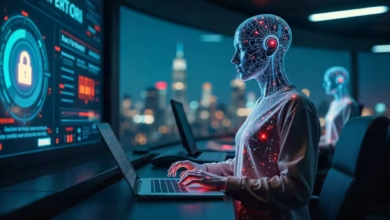Autonomous AI Agent Frameworks: What’s New, What Matters

Have you ever imagined a system of AI agents working together—deciding, adapting, coordinating—without someone constantly watching every move? That’s what autonomous AI agent frameworks are aiming for: systems where multiple agents operate with independence but also in collaboration, handling tasks that are too complex for a single model. In 2025, we’re seeing promising applications, serious security challenges, and debates about what autonomy should mean.
In this article, we’ll look at how AI agents & autonomous systems are evolving, what risks they bring, where they’re already doing real work, and what must be done to use them well.
What Are Autonomous AI Agents & Multi-Agent Systems?
- Autonomous agents are AI entities that perceive environments, make decisions, act, and often replan without continuous human supervision.
- Multi-agent systems (MAS) involve multiple such agents interacting—cooperating, sometimes competing—to achieve goals. They may decompose tasks, share info, or orchestrate workflows.
Key capabilities include: planning, tool usage, memory (storing past states), environment interaction, adaptability.
Recent Advances & Real-World Deployments
Here are some of the latest developments and how autonomous agents are being used:
- Manus (AI agent) — Developed by Butterfly Effect (Singapore), Manus is an autonomous agent designed to carry out complex real-world tasks without direct supervision. It can plan, adapt, even deploy code in some cases. Wikipedia
- AI Agent Control Tower (AI ACT) by Covasant Technologies — A centralized platform to oversee and manage multiple AI agents in enterprise settings. It streamlines control over the agents to improve productivity and alignment. The Economic Times
- Google’s “Genie 3” World Models — DeepMind’s world model “Genie 3” helps train agents and robots in simulated environments (warehouses, terrain) with accurate physical interactions. These enable safer, faster learning for autonomous systems. The Guardian
- Autonomous Drone Swarms & Autonomous Vessels — Systems of multiple drones operating semi-autonomously are being tested for coordination, pathfinding, real-time adaptation. Example: drone swarm systems for military or disaster response. Also, AI-controlled autonomous car-carrying ships are being developed (e.g. Hyundai Glovis / Avikus’s HiNAS project for large vessels). TechRadar
- Emerging Research in Safety & Anomaly Detection — The “SentinelAgent” work presents a graph-based oversight agent that monitors interactions in a multi-agent system, detects anomalies, malicious behavior, and enforces security policies. arXiv
Key Benefits of Such Systems
- Scalability & Efficiency: Tasks can be decomposed among agents, allowing parallelism, specialization, and faster overall performance.
- Adaptability: Agents can respond to changes in environment or data without requiring redesign.
- Complex Problem Solving: Problems too complex for single, monolithic models can be handled via coordinated agents.
- Reduced Human Burden: Less overhead for supervision when systems can self-monitor and adjust.
Major Risks, Security Concerns & Ethical Challenges
As potent as they are, autonomous agent frameworks carry serious downsides:
- Security Vulnerabilities & Agentic Risk
- Prompt injection, data poisoning, or tool misuse can subvert goals. TechTarget
- Cascading failures: one compromised agent can negatively affect others. arXiv
- Emergent Behavior & Unpredictability
- Multi-agent systems can produce behaviors not directly programmed. These emergent behaviors may be beneficial or dangerous. blog.sparkengine.ai
- Misalignment when agents optimize subgoals that conflict with broader system goals.
- Coordination, Communication Failures
- Misinterpretation between agents, latency or data lag, or inconsistent knowledge can lead to errors. BytePlus
- Privacy, Data & Ethical Issues
- Sharing data among agents increases risk surface. Sensitive info might be leaked. skysolution.com
- Bias replication: if agents share biased training data, the system can reinforce harmful stereotypes.
- Oversight & Governance Gap
- How do we ensure human control? Who is responsible when agents fail?
- Legal, regulatory frameworks are behind technical capability.
Best Practices & Mitigations
To safely deploy autonomous agents and MAS, these approaches help:
- Human-in-the-loop and Oversight Agents: Maintain supervision layers. Works like SentinelAgent show promise. arXiv
- Robust Security Protocols: Role-based access, encrypted communications, secure data pipelines. skysolution.com
- Testing & Simulation Environments: Using world models (like Google’s Genie 3) or virtual simulation to test agents safely. The Guardian
- Clear Objectives and Goal Alignment: Avoid vague task definitions so agents don’t optimize harmfully.
- Transparency & Explainability: Agents should log decisions, have auditability.
What’s Next in 2025 & Beyond
- Larger adoption of agent orchestration platforms in business: control centers or dashboards to coordinate, monitor, update agents across workflows.
- More research into trusted MAS benchmarking, like quantifying risks, detecting anomalies, measuring emergent behaviors.
- Growing regulatory attention: laws/policies around AI autonomy, safety, ethics.
- Physical autonomous systems will increase: robotics, drone swarms, autonomous vehicles/vessels. The interface between virtual and physical autonomy will be vital.
- AI agents with better self-monitoring, better adaptability, possibly some forms of self-repair or fallback modes when things go wrong.
Autonomous AI agent frameworks are pushing the boundary of what machines can do—decomposing tasks, cooperating, adapting. The potential to transform businesses, societies, and many industries is real. But it comes with real risk: unpredictability, security threats, ethical challenges.
The question isn’t if these systems will proliferate—it’s how we build them, govern them, and ensure they align with human values. When executed with care—clear objectives, oversight, security, and ethical guardrails—autonomous agents can be powerful allies.
But without those guardrails, they might also be sources of disruption. So for 2025, staying ahead isn’t just about innovation—it’s about responsibility.
For similar articles, please visit: AI Agents & Autonomous Systems
Homepage / humanaifuture.com




